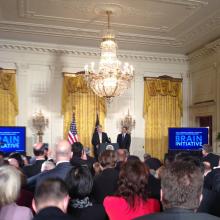
Meet Dr. John Ngai, Director of the NIH BRAIN Initiative.

Nearly 8 years ago on April 2, 2013, I found myself in the East Room of the White House when President Barack Obama launched the BRAIN Initiative. Today, I am privileged to be leading this massive and exciting research endeavor that is meeting his challenge to build new tools that will enable us “to get a dynamic picture of the brain in action and better understand how we think and how we learn and how we remember.” Yet, amid much celebration and excitement, those in attendance on that momentous day saw hard work ahead to show that investing in BRAIN was a wise decision. I, for one, took President Obama’s remarks to heart when he closed the event by saying, “Let’s get to work.” And so, we did.
Together with a highly interdisciplinary group of colleagues at the University of California, Berkeley, I was fortunate to be among the first group of BRAIN awardees in fall 2014. That work, the BRAIN Initiative Cell Census project – which now comprises hundreds of scientists on three continents – is well on its way to generating a comprehensive atlas of the mouse brain, with “big brains” as the next target. This project and hundreds of others funded by BRAIN have created and leveraged new tools and resources to open many new doors to discovery about the inner workings of the brain.
After 27 wonderful years at Berkeley, in spring 2020, I moved into my new role as Director of the NIH BRAIN Initiative. As BRAIN Director, I am humbled to oversee the work being pursued by the brilliant scientists and engineers that we fund and serve alongside more than 100 talented NIH staff from 10 NIH Institutes and Centers who pour their hearts and souls into supporting the mission of BRAIN. Because of their dedication, I could hit the ground running with extensive institutional knowledge at the ready.
The direction – and success – of BRAIN can be traced back to the visionary strategic plan articulated in the BRAIN 2025 report issued in 2014. BRAIN is now emerging from its formative startup phase into a more mature enterprise spanning a wide array of neuroscience and equally broad universe of researchers. To help guide us through this next phase, the “BRAIN 2.0” Working Group reports issued in 2019 provided a critical evaluation of BRAIN’s remarkable progress and highlighted many future opportunities. Over the next few years, BRAIN will launch three large projects to transform the way we conduct neuroscience research and apply this knowledge toward cures. Collectively, these ambitious projects will build a comprehensive atlas of cell types in the human brain; develop and scale up the tools necessary to complete a “wiring diagram” of an entire mammalian brain; and then based on this knowledge, develop molecular and gene-editing therapies to study and treat human circuit disorders.
You’ll notice that the next phase of BRAIN has a human focus. This is intentional. As humans, we yearn to understand this magnificent organ that “makes us who we are, enables us to perceive beauty, teach our children, remember loved ones, react against injustice, learn from history, and imagine a different future,” as written so eloquently by the authors of BRAIN 2025. But there’s another reason. As researchers, we can choose where to look, but what we find is never certain. While many of science’s paradigm-shifting discoveries have and will continue to be born from purely curiosity-driven research, we must be mindful that as each day passes, people suffering from devastating neurologic and neuropsychiatric diseases are being robbed of their very humanity. These individuals and their families are justifiably growing impatient for the cures they so desperately need. It is our responsibility to them – and to ourselves – to use BRAIN investments to turn our remarkable discoveries into cures.
Finally, I am deeply committed to cultivating a community of researchers and scholars that is broad, deep, and diverse – to maintain BRAIN’s innovative streak, while making it sustainable. We’ve seen time and again that scientific breakthroughs often occur at the interfaces between traditional disciplines, with diverse perspectives providing the critical spark leading to innovation.
Watch this space for my perspectives not only on the progress of BRAIN, but also about intersections of BRAIN with topics universal to biomedicine that deserve special attention: diversity, equity and inclusion; data sharing; the way we do science; and other issues of interest that are sure to arise.
With respect and gratitude,
John Ngai, Ph.D.
Director, NIH BRAIN Initiative
